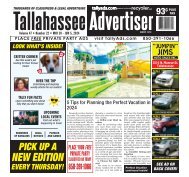TLA66_AllPages
You also want an ePaper? Increase the reach of your titles
YUMPU automatically turns print PDFs into web optimized ePapers that Google loves.
Government affairs<br />
How MUCH<br />
is TOO Much?<br />
Electrification of the<br />
trucking industry has a price<br />
tag of at least $1 trillion<br />
By John Worthen<br />
The cost of fully electrifying the trucking industry is staggering.<br />
There’s a lot more to consider than simply the cost of new<br />
vehicles — which is considerable in itself. The nation will need<br />
to build a network of charging stations that’s capable of powering<br />
thousands of heavy commercial vehicles each day.<br />
A recent study, commissioned by the Clean Freight Coalition (CFC)<br />
and conducted by Roland Berger, reveals that creating a sufficiently<br />
dense long-haul charging network would require an initial investment<br />
of at least $57 billion investment by fuel retailers.<br />
To electrify all medium- and heavy-duty vehicles, fleets and<br />
charge point operators will need to invest $620 billion into chargers,<br />
site infrastructure, and utility service costs, the study notes.<br />
These figures are swirling around the trucking industry, creating<br />
a firestorm of debate.<br />
That’s because the U.S. Environmental Protection Agency (EPA)<br />
on Friday, March 29, released strict new emissions standards for<br />
heavy-duty trucks, buses, and other large vehicles. Officials say<br />
the new standards will help clean up some of the nation’s largest<br />
sources of planet-warming greenhouse gases.<br />
According to the EPA, the new rules, which take effect for model<br />
years 2027 through 2032, will avoid up to 1 billion tons of greenhouse<br />
gas emissions over the next three decades and provide $13<br />
billion in net benefits in the form of fewer hospital visits, lost workdays,<br />
and deaths. In particular, the EPA says, the new standards<br />
will benefit an estimated 72 million people in the U.S. who live near<br />
freight routes used by trucks and other heavy vehicles and bear a<br />
disproportionate burden of dangerous air pollution.<br />
The new rules for heavy trucks and buses came just a week after<br />
the EPA announced new automobile emissions standards for passenger<br />
vehicles, which relax initial tailpipe limits proposed last year<br />
but are close to the same strict standards set out by the EPA for<br />
model year 2032.<br />
The rule for trucks is complex, with a range of electric-vehicle or<br />
other non-traditional sales projected, depending on the type of vehicle<br />
and use. For instance, 30% of heavy-duty vocational trucks and<br />
40% of short-haul day cab tractors must be zero-emission by 2032.<br />
Not long after the release of EPA’s statement, trucking industry<br />
stakeholders — including fuel providers and retailers, as well<br />
as motor carriers and others — were firing out responses. Most<br />
lambasted the new standards as unreachable with current electricvehicle<br />
(EV) technology and pointed out a lack of EV charging stations<br />
and power grid capacity limits.<br />
Most groups say the EPA’s new emission standards for heavyduty<br />
trucks have unachievable targets and will carry real consequences<br />
for the U.S. supply chain and movement of freight.<br />
Like others in the trucking industry, Jim Ward, president of the<br />
Truckload Carriers Association (TCA), believes the new EPA rule<br />
will have a significantly negative impact on its members, as well as<br />
the industry as a whole.<br />
“It’s important to recognize the progress that’s been made by<br />
our many TCA members who have tested equipment, trained both<br />
technicians and professional drivers, while incurring additional<br />
costs along the way to complying with EPA regulations instituted<br />
over the past couple of decades,” Ward said.<br />
“The industry has effectively reduced NOx and particulate matters<br />
through the evolution and implementation of new technologies<br />
and remains committed to being a good steward of the environment,”<br />
he continued. “The journey ahead provides for many<br />
alternatives to be considered to lower carbon, such as blended<br />
biodiesel, renewable natural gas, diesel-electric — just to name a<br />
few — to help us bridge the gap to the future.<br />
“We cannot just sit idly by and watch the implementation of a<br />
policy that will have a significant impact on our members’ business,”<br />
he concluded.<br />
NATSO, an organization that represents America’s travel plazas and<br />
truck stops, and SIGMA: America’s Leading Fuel Marketers, said in a<br />
joint statement that while they appreciate that the Biden administration<br />
is working toward reducing carbon emissions, the new EPA rule is<br />
poised to have negative effects on trucking and its related industries.<br />
“The administration’s final rule does not adequately consider<br />
the challenges that fuel retailers face in transitioning to heavy-duty<br />
truck electrification,” the joint statement noted. “The administration’s<br />
final rule also does not recognize the need to support lower<br />
carbon alternatives to diesel fuel that are currently commercially<br />
viable, such as biodiesel and renewable diesel.”<br />
In addition, reports from the American Transportation Research<br />
Institute (ATRI) identify the many challenges facing commercialvehicle<br />
electrification in the areas of U.S. electricity supply and demand,<br />
electric vehicle production, and truck-charging requirements.<br />
“Off-highway refueling locations will need dozens of fast-<br />
Sponsored by SCALE FUNDING / GETSCALEFUNDING.com / 800.707.4845<br />
8 Truckload Authority | www.Truckload.org TCA MAY/JUNE 2024
















